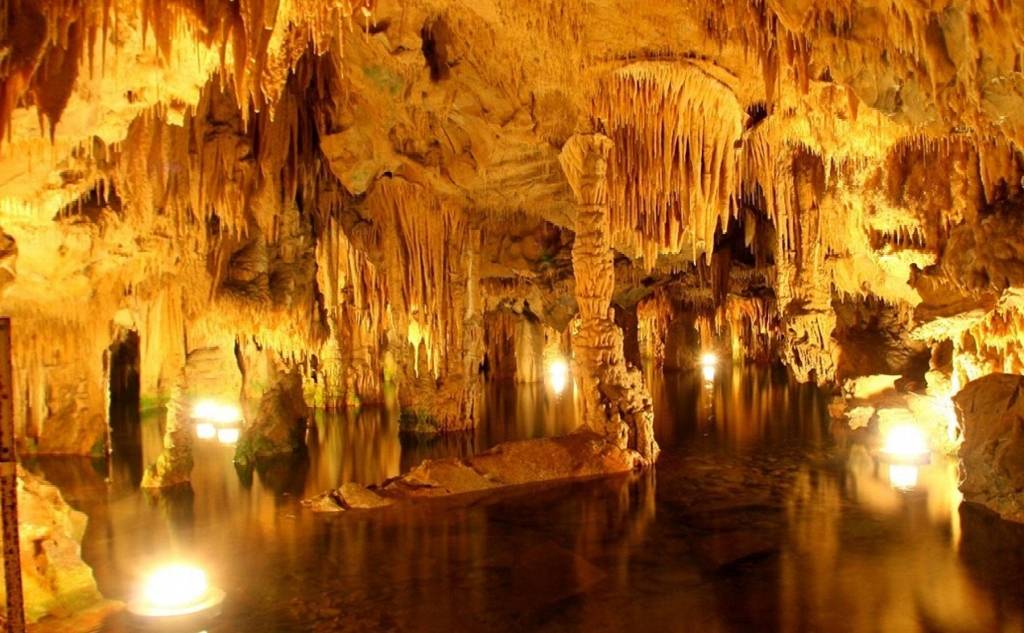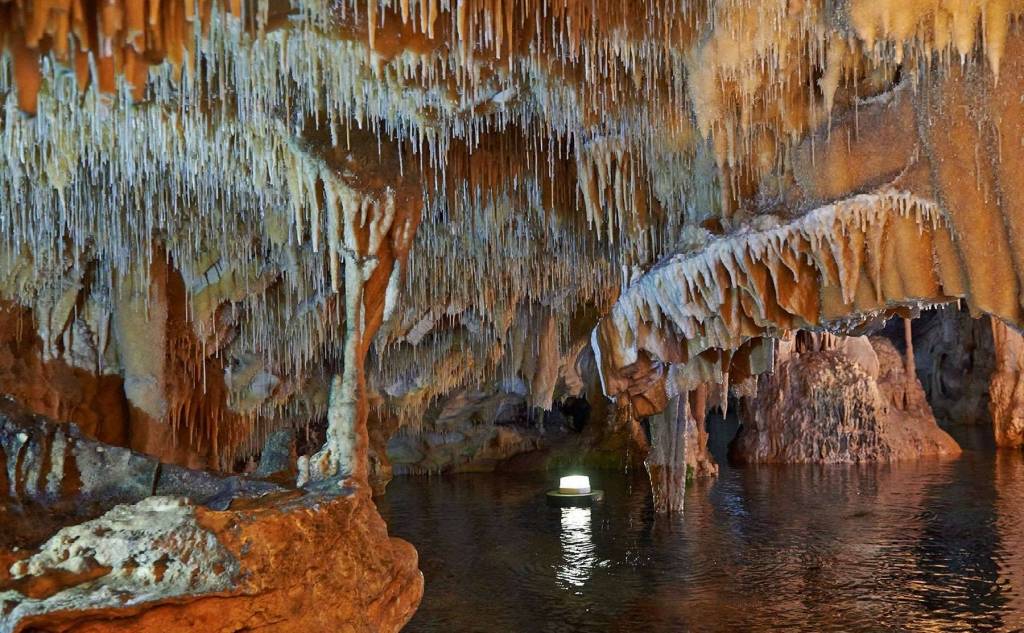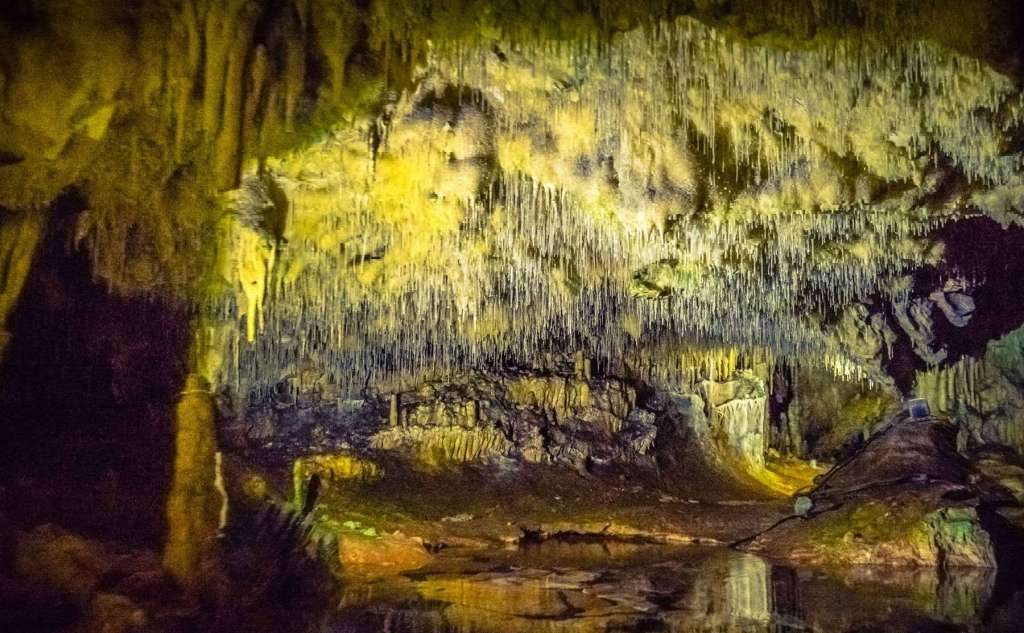Diros Caves
South of Areopolis, on the west coast of the Laconic Peninsula, at the Bay of Diros, the visitor will find the Caves of Diros.
There are two caves in the area, the one called Alepotrypa and the other Glyfada or Vlychada. In their interior, underground rivers, around which an entire world of stalactites and stalagmites has been formed, a work of hundreds of thousands of years, are flowing.
The Glyfada or Vlychada Cave has been described as the most beautiful in the world of its kind, together with Jeita Grotto in Beirut and Gouffre de Padirac in France. Petros Arapakis first discovered the cave in 1898. Therefore, since 1900, the locals knew of its existence, but no one could have imagined what was hidden in its interior until 1949. Then, its systematic exploration began by John and Anna Petrocheilou, founders of the Greek Speleological Society. By 1960, 1600 meters had been explored and mapped, while in 1970, the first underwater exploration took place. Since 1987, the Office of Paleoanthropology- Speleology of the Ministry of Culture has begun the detailed study of the cave in collaboration with an international cave-diver team. Up to now, 14,700 metres of routes have been mapped, and the most significant part of the cave is situated below the water surface. Impressive is the fact that stalactites have been found at a depth of 71 meters, while the maximum depth of the cave has been located off the tourist route, reaching 80 meters. The cave's natural entrance has a diameter of just half a meter while, in the past, the cage had other entries that gradually closed. The water in the cave is saline, and its temperature is about 14 C.
The fossilised bones of panthers, hyenas, lions, deer, martens, and the largest deposit of hippopotamus bones in Europe have been discovered inside the cave. The pottery found near the cave’s natural entrance indicates the human presence.
There is a souvenir and gift shop in the cave area and a refreshment bar where visitors can enjoy coffee or snacks. Additionally, for those interested, there is a portable automatic tour device. It is available free of charge and can be found at the cashier’s at the entrance. The machine is automatic, and the tour is available in five different languages: Greek, English, German, Italian and Russian.
The Route
The touristic route extends up to 1500 metres, of which the boat ride covers 1200 metres in the first lake and lasts about 45 minutes. Bright white stalactites and stalagmites adorn every cave corner, and the journey begins…
The first room is dominated by the stalagmite known as "Cactus”; further away, "The Cloak of Neptune” hangs on the roof. This space is the starting point of the journey. Next are the "Dead City” and the "Crossroad”, where we meet the "Hercules’ Pillars". The "Lake of the Oceanids" with the "Little Thimonia” stalagmite in the centre, the "Forest of Palm Trees”, the "Corridor of Miracles”, and the "Faithful Dog” enchant the visitor with their unique beauty.
In the next room, there is the "Great Thimonia”, with a diameter of 3,5 meters, "The Kiosk”, the "Kathedrali”, the "Bishop’s Throne”, the "Stone Lily”, and the "Bed of Neptune”. The journey continues, passing under the "Chandelier” followed by the chamber with the "Ancient Greek Chlamyds”. Next, there are the "Pink Apartments” with the "Royal Balcony”, the "Beautiful Gate” and the "Hanging Fox” with its bushy tail.
The snow-white decoration of the next lake with the "Small, White, Bridal Fairy Beds” and the famous "White Apartments” leave the visitor speechless. Leaving the "Chapel”, there is the "White Corridor”, ending in the "Sea of Wrecking” with the "Sunken Ship”, its masts rising out of the water. Next, there is the "Chocolate Hall” (covered in dark mud) and the “Red Hall” (covered in reddish mud).
The "Cave of the Dragon”, with the vast rock hanging from the ceiling, looks like a dragon with its mouth open. Next, we see the "Tower of Pisa”. It is a column that took its name from the slope caused by erosion. The "Venetian Canals” end up in the cave's most significant and imposing part, the "Great Ocean”, 160 meters long and 30 meters wide.
The visitor meets the "Crystal Rain” and the "Big Disk” that complete the lake route in the next room. The onshore section that follows it is just as impressive, with various colours and shapes. The "Chinese Pavilions”, the "Flowering Stalagmites”, and the "Monument of the Unknown Sailor” are standing out. The uphill part continues by a metal staircase, while the downhill, on the opposite side, ends at "Neptune’s Palace” with the "Theatre Scene”, the "Diamond Column”, the "Stone Forest” and the "Harmonium”. Finally, the "Water Lilies” complete the fascinating cave tour.
The Alepotrypa cave (meaning "fox hole" in Greek) was accidentally discovered in 1958 by Apostolis Labrinakos when his dog while chasing a fox, fell into the cave's hole and came out three days later. It is a two-storey underground riverbed. Significant anthropological findings of the Late Paleolithic-Neolithic period were discovered in its interior, making it one of Europe's most important natural museums. Human skeletons, skulls, animal skeletons, marble figurines, tools, vessels, and a stone axe were discovered. It is believed that the unfortunate inhabitants of the cave were trapped inside after a strong earthquake. The Neolithic man used Alepotrypa as a shelter, a home, a warehouse, a cemetery and a place of worship for the dead.
Basic "stations" along the route are the stalagmite called "Olive Tree" in the first chamber, close to which a clay pottery workshop was found, as well as the “Place of Worship”, which turned black by the torches used during religious ceremonies. Today, the cave is not open to the public. However, visitors may see many of the findings at the Museum next to the cave entrance.






